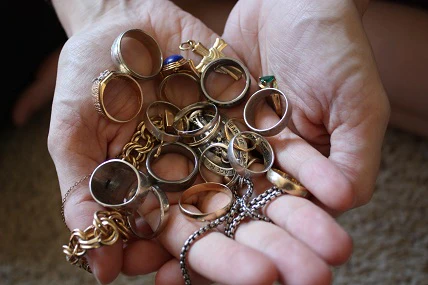Embarking on a treasure hunt with a metal detector is an adventure filled with excitement and mystery. Each beep might lead you to a hidden relic or a piece of history buried beneath your feet. However, the thrill continues beyond discovery; correctly identifying and cleaning your finds is crucial to unveiling their value and preserving their story. This guide will take you through the essential steps to identify and “How to clean old coins at home,” ensuring they shine with their historical significance and potential value. Join us as we delve into the world of metal detecting finds, where every clean-up is a step closer to the past.
Tools and Equipment Needed
When you're ready to dive into cleaning your metal-detecting finds, having the right tools and equipment is vital to doing the job properly without damaging your treasures. Let's break down what you'll need into three categories:
Basic Tools
- Soft brushes: Ideal for gently removing dirt and debris without scratching the surface of your finds.
- Toothpicks: Perfect for picking out dirt from the nooks and crannies of intricate items without causing harm.
- Magnifying glass: A must-have to closely inspect your finds and assess them for any delicate details that require extra care during cleaning.
Advanced Equipment
- Ultrasonic cleaners: Use high-frequency sound waves to clean items thoroughly and gently, ideal for more delicate or intricate finds.
- Electrolysis setups: A more advanced option for removing corrosion and rust from metal objects, but you should use it cautiously to avoid damaging the item.
Safety Gear
- Gloves: Protect your hands from sharp edges and any potentially harmful chemicals used during cleaning.
- Protective eyewear: Protecting your eyes from any particles or cleaning solutions that could cause irritation or injury is essential.
Equipping yourself with these tools and ensuring you have the appropriate safety gear will set you up for successful cleaning sessions, preserving the integrity and history of your metal-detecting finds.
How to Start Cleaning Metal Detecting Finds
Diving into the world of metal detecting finds can be like opening a treasure chest—you never know what you'll discover! When you buy metal detectors online, look for tools that can help you locate a range of finds. Here's how to start cleaning those treasures without turning them into tarnished remnants of history.
Initial Steps
- Begin by identifying the material types of your finds, such as iron, copper, gold, or silver. Each material will require a different cleaning approach.
- Assess the condition of each item. Look for signs of significant wear or fragility that might affect how you clean it.
Importance of Gentle Cleaning
Always opt for the gentlest cleaning method possible to avoid damaging your finds. Sometimes, less is more, and a light brushing will reveal the beauty beneath the grime.
Quick Tips on Organizing Finds for Cleaning
- Sort your finds by material type to streamline the cleaning process. This organization will help you apply the most appropriate cleaning methods for each group.
- Keep a log or take photos of your finds before and after cleaning. This record can be invaluable for historical reference or if you decide to display or sell your items.
By starting with these carefully considered steps, you ensure each piece gets the care it needs and retains its historical integrity and value.
Cleaning Techniques for Metal Finds
Embarking on the journey of cleaning your metal-detecting finds like dirty coins can be as thrilling as the initial discovery. Tools like Garrett metal detector coils can find a range of items. Each item, from old coins to gleaming jewelry, holds a piece of history that deserves careful preservation. Here's how to clean your treasures thoughtfully and effectively:
Cleaning Coins
Coins like steel pennies are often the most exciting, but they require a gentle touch to preserve their numismatic value. A soft brush and soapy water can remove dirt for less valuable collectible coins without damaging the surface. More valuable items like silver coins might only need a rinse with distilled water to preserve their patina and historical significance. You can also clean coins using specialized solutions.
Cleaning Jewelry, Relics, and Artifacts
Each type of find requires a tailored approach to cleaning.
- Jewelry: Often delicate, jewelry should be cleaned with mild soap and water, using a soft brush to remove dirt gently. Avoid harsh chemicals that can damage older metals or gemstones.
- Relics and Artifacts: These pieces range from iron tools to delicate pottery. For metal objects, a toothpick can help remove grime from nooks without scratching. It would help if you cleaned non-metal artifacts according to their specific material, often with a soft brush and patience.
DIY Cleaning Solutions vs. Commercial Cleaners
Choosing the proper cleaning solution is crucial to avoid damaging your finds.
- DIY Solutions: A mixture of water and baking soda is safe for many metals, offering a gentle way to clean without harsh chemicals. Dry them using a soft cloth or paper towel.
- Commercial Cleaners: There are cleaners explicitly formulated for different metals. These can be effective, but you should use them with caution. Always read the label and, if possible, test on a less valuable item first.
By adopting these techniques, you ensure that you clean your metal-detecting finds in a way that preserves their history and beauty.
How to Eliminate Mineralization
Mineralization, a common issue for buried metal objects discovered with metal detectors with waterproof properties, results from long-term interaction with soil and water, forming mineral deposits that can obscure details. We recommend gentle soaking methods to tackle this. Placing the item in distilled water for days may loosen deposits, allowing easy removal with a soft brush. Natural acids like diluted vinegar or lemon juice can dissolve the buildup for more challenging cases. It's crucial to proceed cautiously, frequently checking the item and thoroughly rinsing it afterward to prevent damage. Testing a small area ensures that the cleaning method preserves the metal's integrity and detail.
Removing Rust and Corrosion
Here's how you can remove rust and corrosion from your treasured metal finds:
Different Approaches for Ferrous and Non-Ferrous Metals
Rust primarily affects ferrous metals (those containing iron), while non-ferrous metals can suffer from corrosion. Identifying the metal type before choosing a cleaning method is crucial, as treatments differ significantly between the two.
Mechanical Removal Techniques vs. Chemical Treatments
For mild rust on ferrous metals, mechanical methods like using a soft wire brush or sandpaper can be effective. Non-ferrous metals with corrosion may benefit from gentle polishing. When mechanical methods fall short, chemical treatments can be used, such as rust removers for ferrous metals or vinegar for non-ferrous metals. Always test these treatments on a small area first.
Avoiding Common Cleaning Mistakes
One of the biggest blunders in cleaning metal detecting finds is using harsh chemicals or abrasive tools without considering the material's delicacy. Such actions can irreversibly damage the surface, erasing historical marks or inscriptions.
Patience is your best ally. Rushing the cleaning process or skipping the step of testing cleaning methods on less valuable items first can lead to regrettable outcomes. Always start with the gentlest method and test on an inconspicuous area or a less useful find to gauge the reaction. This cautious approach can save you from unintentionally damaging your more prized discoveries, ensuring they remain as intact and authentic as possible.
Conclusion
In the world of metal detecting, the thrill of discovery is matched by the responsibility of preservation. Proper cleaning techniques are crucial for maintaining your finds' integrity, historical significance, and value. As you uncover treasures hidden beneath the surface, remember to clean with care, patience, and respect for their past. Doing so ensures that these artifacts can share their stories that future generations will appreciate. Let your discoveries shine responsibly.




Leave a comment